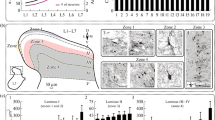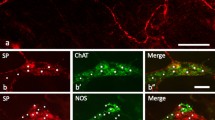Abstract
The aims of the present study were: (1) to evaluate BODIPY forskolin as a suitable fluorescent marker for membrane adenylyl cyclase (AC) in living enteric neurons of the guinea-pig ileum; (2) to test the hypothesis that AC is distributed in several subpopulations of enteric neurons; (3) to test the hypothesis that the distribution of AC in the myenteric plexus is not unique to AH/Type 2 neurons. BODIPY forskolin was used to assess the co-distribution of AC in ganglion cells expressing the specific calcium-binding proteins (CaBPs), calretinin, calbindin-D28, and s-100. Cultured cells or tissues were incubated with 10 μM BODIPY forskolin for 30 min and fluorescent labeling was monitored by using laser scanning confocal microscopy. BODIPY forskolin stained the cell soma, neurites, and nerve varicosities of Dogiel Type I or II neurons. About 99% of myenteric and 27% of submucous ganglia contained labeled neurons. About 14% of myenteric and 3% of submucous glia with immunoreactivity for s-100 protein displayed BODIPY forskolin fluorescence. BODIPY forskolin differentially labeled myenteric neurons immunoreactive for calbindin-D28 (80%) and calretinin (17%). The majority (63%) of BODIPY forskolin-labeled myenteric neurons displayed no immunoreactivity for either CaBP. In submucous ganglia, the dye labeled 44.6% of calretinin-immunoreactive neurons, representing 21% of all labeled neurons; it also labeled varicose nerve fibers running along blood vessels. AC thus exists in myenteric Dogiel type II/AH neurons, enteric cholinergic S/Type 1 neurons, and other unidentified non-cholinergic S/Type 1 neurons. Our data also support the hypothesis that AC is expressed in distinct functional subpopulations of AH and S neurons in enteric ganglia, and show that BODIPY forskolin is a suitable marker for AC in immunofluorescence co-distribution studies involving living cells or tissues.
Similar content being viewed by others
Author information
Authors and Affiliations
Additional information
Received: 22 August 1997 / Accepted: 20 October 1997
Rights and permissions
About this article
Cite this article
Liu, C., Zhang, H. & Christofi, F. Adenylyl cyclase co-distribution with the CaBPs, calbindin-D28 and calretinin, varies with cell type: assessment with the fluorescent dye, BODIPY forskolin, in enteric ganglia. Cell Tissue Res 293, 57–73 (1998). https://doi.org/10.1007/s004410051098
Issue Date:
DOI: https://doi.org/10.1007/s004410051098




